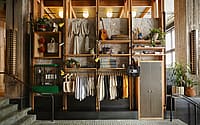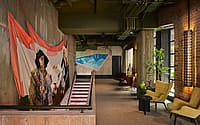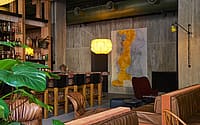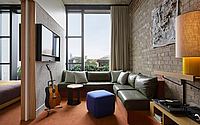Ace Hotel Sydney by Flack Studio
Ace Hotel Sydney is a beautiful hotel located in Sydney, Australia, redesigned in 2022 by Flack Studio.

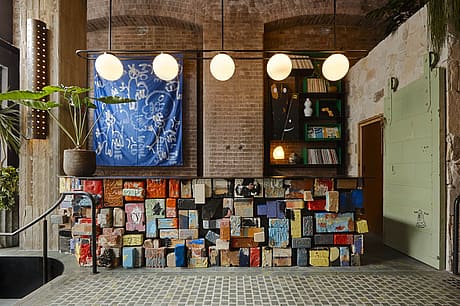
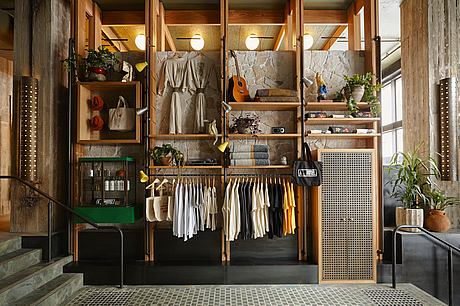
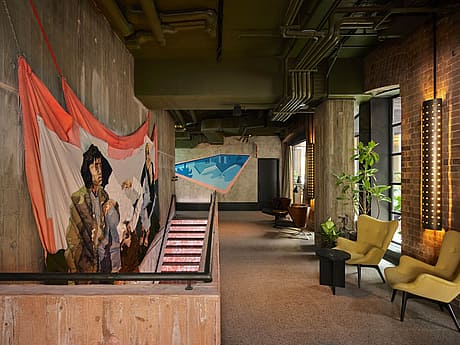

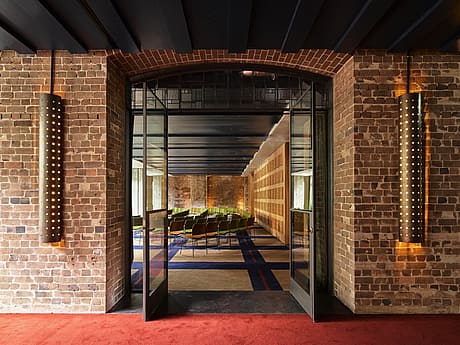

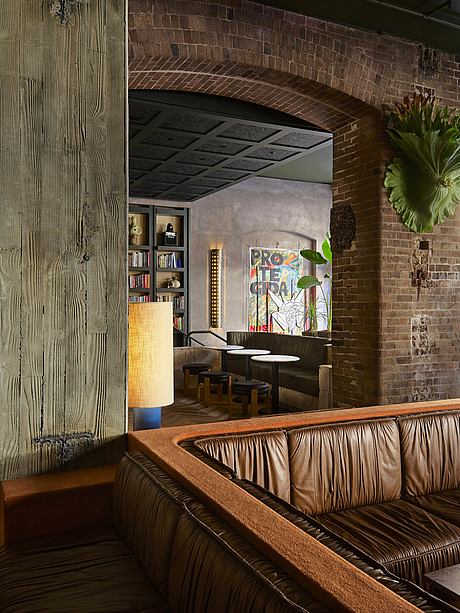
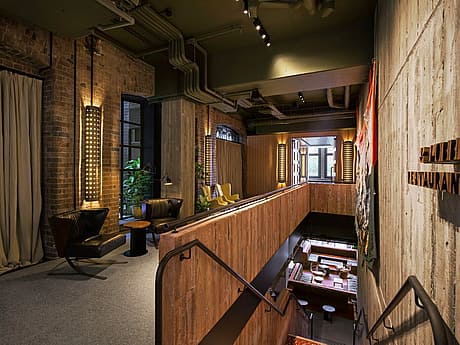


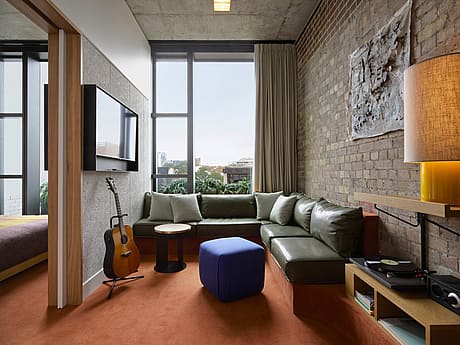
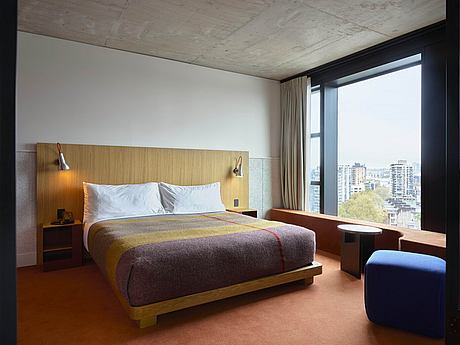

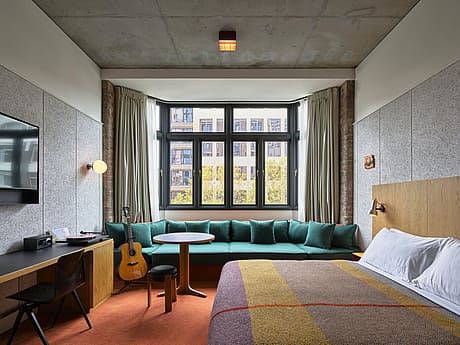
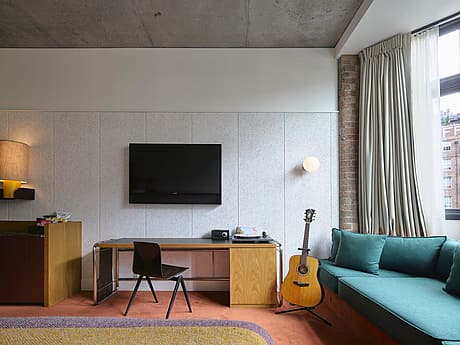

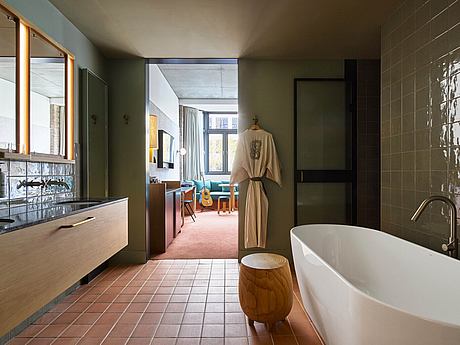
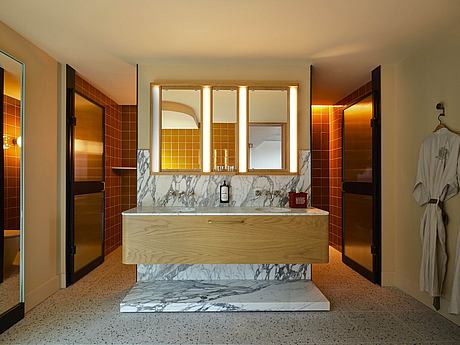
Description
Ace Hotel Sydney, our very first spot south of the equator, is a sweeping re-imagination of a historical building that has stood for over a century. The project is tremendous in scope, adding eight new floors to the heritage building, which is nestled in one of Sydney’s most culturally significant neighborhoods. Preserving the structure’s character in spirit yet constructed to reawaken its spaces, the 257-room hotel is a deep homage to Australia and the boundless and edgy creativity that has always called this country home. Rising 18 stories, Ace Hotel Sydney includes a lobby bar, ground-floor restaurant, and laneway cafe, as well as a rooftop restaurant and bar.
The hotel’s lead design partner, Flack Studio, found their inspirational starting point for Ace Hotel Sydney in a landscape painting by Indigenous Australian artist Albert Namatjira; the scene’s warm, natural tones echo throughout the space. The team also pulled inspiration from influential design theories that emerged right here, namely architect Robin Boyd’s The Australian Ugliness. The hotel seamlessly weaves its nods to the past into modern flourishes, showcasing an extensive art program that includes works of all sizes by some of Australia’s most daring new voices in art. Contrasting and blending layers of natural materials and textures, custom furniture and lighting, and playful contemporary art, Flack Studio’s work for Ace Hotel Sydney lays down a strong new market for Australian design today.
Neighbourhood & History
Surry Hills is a microcosm of Sydney’s singular character; its meandering streets establish a rhythm of creation and innovation that rings across the city and the country. It is home to a multicultural confluence of industry and residential living, built upon a significant past. Surry Hills was the site of the razor gang wars and underground liquor trade in the ’20s and ’30s; the onetime centre of the local rag trade; the headquarters of the Gay Solidarity Group in the ’70s; a home for generations of vital
immigrant communities. Today, art galleries, design stores, restaurants, and bars line its thoroughfares and host an engaged local community. Surry Hills’ vibrant energy is influenced by its proximity to the rich culture and exciting culinary scenes in Thaitown and Chinatown, which are mere steps from the hotel, as well as its nearness to Redfern — one of the most significant sites of First Nations activism in the country, and a continuing hub for Aboriginal art, culture, and community.
The site of Ace Hotel Sydney is home to Australia’s earliest kiln discovery, dating back to the 1820s, when convict potter Jonathan Leak and his wife, Mary, set up base on Wentworth Ave to produce domestic pottery including bricks, tiles, pots, jugs and pipes. In 1916, following the site’s life as a production centre for Leak, the Tyne Building was erected, which served as a dispensary and warehouse for Washington H. Soul Pattinson & Co, a well-known Australian pharmacist, later becoming a garment factory and then Key College House, an independent high school for at-risk or underprivileged children. All four of the original building’s 10-story exteriors were restored during the construction of the hotel, and reveal themselves in both the public areas and some guestrooms, providing a reminder of the many lives the building has lived.
Materials
Inspired by the visionary Australian modernist architect Robin Boyd and his book, The Australian Ugliness, Ace Hotel Sydney embraces materials reflective of the utilitarian history of the building, and the neighbourhood, to tell its story. The use of raw materials throughout the design, such as the off-form concrete walls, locally sourced timber and aged brass seen throughout the building honour this historical site while creating comfortable and communal spaces. The materiality throughout the hotel’s interior speaks to Sydney’s landscape and natural resources: terracotta tiles in the guest rooms, sandstone feature walls on the ground floor and an ochre-red marble staircase leading from the ground floor to level one. Classic materials — oak, brick, leather, raw concrete, steel, marble — applied in inventive ways merge the historic and the cutting edge within the building.
Ace Hotel Sydney’s wayfinding and signage were designed by Studio Ongarato, with an emphasis on ’70s modular design, textural materials and bold geometric forms. A sense of handcraft is present in carved timber blocks, glazed ceramic room signage and hand-painted details on the entry signs.
Front Desk and Lobby
Ace Hotel Sydney’s main entrance is on Wentworth Ave, a thoroughfare connecting Surry Hills to the city’s central business district. Entering from Wentworth Ave, guests encounter a striking art installation: the hotel’s reception desk, a commissioned piece by ceramicist James Lemon, is made up of polychromatic glazed brick in recognition of the site’s industrial past and its dynamic new life. Framing the reception desk are works by Sydney-based artist Nell, whose pop culture-referencing work is on
display with Two Sounds (2011) and a large wall-hung work by multidisciplinary artist Jason Phu, who uses references from traditional ink painting and calligraphy in if the moon farted all the birds would die (2021).
Opposite the front desk sits Ace Hotel Sydney’s retail collection, a curated selection of apparel and gifts designed by in-house creative team, Atelier Ace. Also featured in the ever-rotating collection — select items from guest rooms, including the custom-designed Rega record players and Tivoli radios, custom-designed Deiji Studios robes with insignias by artist Jason Phu, Studio Henry Wilson-designed brass wall hooks, a Flack Studio stool, and an Ace signature item: a custom-designed blanket, made in collaboration with New Zealand heritage wool weavers Stansborough and Flack Studio, featuring a colour palette inspired by the landscape paintings of Indigenous Australian artist Albert Namatjira.
Floor-to-ceiling windows looking onto Wentworth Ave illuminate the lobby lounge — a common space open to the public, activated by music, art and industry, and a hallmark of the Ace brand. The Lobby’s glass frontage gives a bright, airy feel to the space, which is framed with sandstone walls and lush foliage. Reclaimed brickwork, warm terracottas, tans and greenery are continued throughout the floor, inspired by Australia’s native landscape.
The Lobby features a marble bartop, with bar stools custom-designed by Flack Studio lining the service area. The sunken lounge, which sits in the centre of the room, is another wink to ’70s Australia — made from an ochre-orange carpet, with pleated tan leather cushions, it invites guests to sink into conversation. The central lounge is echoed in the guestroom design, with most rooms featuring an inviting nook in which to recline or converse. A work by renegade ceramic sculptor Ramesh Mario Nithiyendran watches over the space.
An ochre-red marble staircase ascends from the ground floor to the level-one event spaces. Framing the staircase to the left is Julia Gutman’s large-scale tapestry, Once More, with Feeling, made from clothing previously owned by Gutman and her friends. Upon reaching the level-one landing, guests are greeted with a commissioned painting by the Perth-based artist Joanna Lamb — one in her on-going series of paintings of suburban swimming pools.
Furniture
Nearly all of the furniture and lighting in the hotel is custom-designed by Flack Studio and their collaborators — from the banquette seating in LOAM, to the bar stools in the lobby, to the beautiful sconces placed throughout the ground floor. Woven into the custom work by Flack Studio are other iconic modernist designs: lighting by Isamu Noguchi, the Tobia Scarpa “Nuvola” lamp framing The Lobby bar and select vintage chairs peppered throughout the hotel’s interior. In keeping with the building’s design, the materials used are raw yet refined, with a modern edge: armchairs and stools of oak accented with green velvet or black leather, marble tabletops and linen lamp shades.
Dining and Drinking
Ace Hotel Sydney is home to four venues for eating and drinking. The Lobby, a cocktail bar and lounge, serves as the hotel’s central gathering space and offers a wine menu curated by our friend Mike Bennie of P&V Wine + Liquor Merchants. Bennie compiled a tight but dynamic offering of wines by the glass and bottle to complement the menu’s craft beers, cocktails, snacks and shareable small plates. In addition, the bar also regularly hosts arts, music and cultural programming for hotel guests and neighbours.
Located on the ground floor, LOAM serves breakfast, lunch and dinner to the neighbourhood daily. Sister in name and spirit to our Downtown Los Angeles restaurant, LOAM is focused on creating the best product from the highest-quality ingredients. The seasonal menu features vegetable-forward cooking coupled with sustainable meats and seafood, all sourced from the region’s best independent farmers, ranchers and fishermen. Framed by leather banquettes, LOAM is an easygoing place to grab a quick bite or a relaxed meal with friends. The space features a commissioned earthenware mural of glazed wall tiles by iconoclastic ceramic sculptor Glenn Barkley.
Situated along the hotel’s Foy Lane entrance is Good Chemistry, a day-to-night cafe and bar with seating in an airy space that opens fully onto the laneway. The cafe’s name is a callback to one of the space’s past lives as the factory of Soul Pattinson. Nearby, you’ll see a large restored safe that’s been housed in the building since the first half of the 20th century, and another Ace Hotel staple: a vintage photo booth. Good Chemistry is open all day, serving a dining menu of breakfast dishes, fresh baked pastries, market-driven salads, toasties, conservas and light bites, all complemented by pours of Sydney’s own Mecca Coffee and Tea Craft along with draught wine and beer.
Eighteen stories above the city is Kiln, the hotel’s rooftop restaurant and bar. Unlike the rest of the hotel, Kiln was designed by Fiona Lynch Office, who took inspiration from the work of pioneering Italian-Australian architect Enrico Taglietti and Australia’s native grasses, sandstone plateaus, hardened blue clay and lush eucalyptus. The space created is uniquely Australian, with its keen attention to locally sourced sustainable materials such as reclaimed timber, recycled glass and natural leather. In a one-of-a-kind expression of inspiration, Lynch collaborated with Spacecraft Studio to create a unique dye process for Kiln’s textiles: salvaged materials from the building site were crushed into pigments that were then used to color the room’s linens. These custom-painted linens drape the walls and wrap window frames, softening the atmosphere and paying homage to the building’s past life as a garment factory.
The restaurant is led by Chef-Partner Mitch Orr (formerly of Duke Bistro, ACME and Pilu), who is renowned for his innovative, yet unpretentious, genre-bending cooking. Kiln offers a seasonal menu designed for sharing that draws inspiration from the flavour-rich cuisines of Italy, Japan and Southeast Asia. Kiln offers two open-air terraces with retractable roofs, and is surrounded by walls of windows offering a rarely seen vantage of Sydney. The restaurant’s name is a nod to Ace Hotel Sydney’s previous history as the site of convict potter Jonathan Leak’s kiln, the earliest discovery of such a pottery oven in Australia. Kiln will be open nightly for dinner service and on weekends for brunch.
Guest Rooms
In designing the guest rooms, Flack Studio followed the modernist principle that everything should have its proper home. Each detail was carefully considered: from the colour palette of warm ochres, terracottas and sunset orange, designed to envelop the guest and offer a counterpoint to the urban environment outside; to the custom-built furniture and joinery, made to nestle into the idiosyncrasies of the heritage building with ease; to the custom-designed leather accessories throughout, made to house the minibar and amenities, as well as create nooks for the traveller to store their sundries.
Walls feature textural straw panelling, complementing other materials like raw concrete, tangerine-colored carpet, natural American oak, marble counters, green bathroom tile, leather candy boxes and vintage fabrics. A custom hook from Studio Henry Wilson is used throughout the rooms. Nostalgic colours are seen in abundance: grassy greens and warm oranges, muted brown, pops of cobalt. The first 10 floors of the hotel are part of the original building, while eight additional floors have been added above. The custom joinery and furniture give the rooms a residential feel, while the nuances between the heritage building and the new addition mean rooms are unique in detail and character. In the heritage rooms on the lower levels of the hotel, exposed brickwork is seen, while the newer levels have terrazzo flooring. Some of the rooms have terrace balconies — a result of the vertical tower addition — while others feature historic bay windows overlooking Wentworth Ave to the east, or oversize steel and glass factory windows overlooking Foy Lane to the west.
Robes, an Ace signature, are made by Byron Bay–based sleepwear brand Deiji Studios and feature two custom motifs designed by artist Jason Phu. Custom Ace bedding outfits the beds along with a blanket made in collaboration with heritage wool brand Stansborough. Bath products from Japanese brand uka are installed in the bathrooms.
Custom wall sconces and lamps create a sense of cosiness. Most rooms have their own unique seating — a vintage chair, a daybed, or a custom in-built couch — inviting the guest to sink into the space. As for entertaining, select rooms feature D’Angelico acoustic guitars, and others, turntables by Rega. A clutch of vinyl records, hand-selected by Michael Kucyk of adventurous Melbourne-based record label Efficient Space, are there for playing.
Art Program
For the hotel’s art program, Flack Studio curated an excitingly diverse selection of Australian artists’ works to display throughout the building. The experience starts at the front desk, where an eye-catching glazed-brick work by the artist James Lemon creates a striking encounter. The artists in the collection are at the forefront of contemporary Australian art, and are a group that shares Ace’s playful creativity in their approach. There’s a ceramic library that’s inspired by the building’s former life as a ceramic kiln, featuring works by Nabilah Nordin, Scott Duncan, Ben Mazey, Laith McGregor, Kenya Peterson and more. Tony Albert, a First Nations artist whose work incorporates what Albert terms as “Aboriginalia” — kitsch objects, primarily made for use in the domestic realm, that are adorned with stereotypes of Indigenous Australians — is featured in the ground floor passageway between the lobby and Good Chemistry, with a series of collaborative works titled Mid Century Modern. Jason Phu’s work can be spotted in multiple locations throughout the hotel — his commissioned ink drawings appear in corridors on guestroom floors, and his hand-drawn work also features on the Deiji Studios robes in the guest rooms. Nadia Hernandez’s Protegida, nos llaman (tiernos, raspados, semi-licuados) / Protected, they call us (tender, scraped, semi blended) greets guests in the lobby lounge area, with one of Ramesh Mario Nithiyendran’s sculptures taking pride of place near the sunken lounge in the lobby. A comprehensive catalogue of the Ace Hotel Sydney art program can be found in the supplementary Ace Hotel Sydney Art Overview document.
Event Spaces
On the ascent to level one, Julia Gutman’s Once More, with Feeling is hung — a large-scale tapestry work made from clothing previously worn by Gutman and her friends. Joanna Lamb’s commissioned painting of a swimming pool greets those arriving on the landing. Three event spaces are available on this floor and can be combined to suit any occasion. Tyne can accommodate up to 50 people for a cocktail event and has views to Foy Lane. Clay is of similar size, with Wentworth Ave views and proximity to the largest of the floor’s event spaces, Brick. Brick, which can hold up to 120 guests (180 in total when combined with Clay), has tree-lined views to Wentworth and is perfect for gatherings on the larger side. The entirety of level one makes prominent use of reclaimed brickwork and restored archways, with large glass windows onto Wentworth looking across the street to the historical Griffith Teas building. Additionally, Kiln, LOAM and Good Chemistry can be reserved for events.
About Ace Hotel Sydney
Ace Hotel Sydney reanimates the historical Tyne Building in Surry Hills, built above Australia’s first kiln discovery. Inspired by the rich history of Surry Hills and the warm, cinematic color palette of the Australian landscape, the 257-room hotel marks Ace’s very first stake in the Southern Hemisphere and was designed in partnership with Flack Studio. The building’s organic design merges the past with the present, stirred by the city’s rough-hewn history: the renegade razor gangs that ruled the 1920s, the modernist art boom of the 1960s, the Gay Solidarity Group protests of the 1970s and the vibrant cultural coalescence of generations of migrant communities. LOAM, a neighborhood spot for natural fare, anchors the lobby level along with cafe and bar Good Chemistry, plus there’s a cocktail bar smackdab in the hotel’s lobby. Up top there’s Kiln, an 18th-floor rooftop restaurant and bar helmed by genre-bending Chef Mitch Orr, with a striking dining room designed by Fiona Lynch Office. Ace Sydney is a neighborhood place, with an invitation open to all — come join us in the sunken lobby lounge, where everything happens and everyone’s a part of it.
Photography by Anson Smart
Visit Flack Studio
- by Matt Watts

